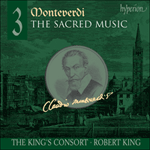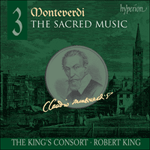From its style, this setting of Psalm 126 appears to be one of Monteverdi’s last pieces of church music, and possibly one of his last compositions. It is not found in
the Selva morale but in the posthumous
Messa a quattro voci et salmi, which suggests that it was written between 1641 and 1643. It is mainly constructed over a jaunty walking bass in the manner of a canzonetta, but at the word ‘surgite’ (‘get up’) the onward flow is interrupted by a series of fanfares passing from voice to voice which are themselves contrasted with a series of exquisite dissonances illustrating the word ‘doloris’ (‘misery’). The doxology contains two of Monteverdi’s favourite devices: cascades of ornaments at the word ‘Gloria’ followed by the traditional pun at ‘Sicut erat in principio’.
from notes by Peter Holman © 1981
D’après son style, cette version du Psaume 126 semble être l’un des derniers morceaux de musique religieuse de Monteverdi, et peut-être I’une de ses dernières compositions. On ne la trouve pas dans le
Selva morale, mais dans la
Messa a quattro voci et salmi posthume, ce qui suggère qu’elle daterait de 1640–43. Elle se base sur une figure de basse enjouée, à la manière d’une canzonetta, mais au mot «surgite» (debout), le flot sonore est interrompu par une série de fanfares passant d’une voix à une autre et contrastées avec une série d’exquises dissonances illustrant le mot «doloris» (douleur). La doxologie comprend deux des procédés favoris de Monteverdi: des cascades d’ornements au mot «Gloria», suivies d’un retour au début du psaume à «Sicut erat in principio»: une sorte de jeu de mots musical.
extrait des notes rédigées par Peter Holman © 1981
Français: Madeleine Jay
Vom Stil her scheint die Vertonung von Psalm 126 eines der letzten Kirchenmusikstücke Monteverdis zu sein, möglicherweise sogar eine seiner letzten Kompositionen. In der
Selva morale ist sie nicht zu finden, jedoch in der posthum veröffentlichten
Messa a quattro voce et salmi, was auf ein Entstehungsdatum von etwa 1640–43 schließen läßt. Sie besteht in der Hauptsache aus einer beschwingt laufenden Baßfiguration nach Art einer Kanzonette, doch bei dem Wort „surgite“ („erhebt euch“) wird der Vorwärtsfluß durch eine Reihe von Fanfaren unterbrochen, die von Stimme zu Stimme springen, die selbst mit einer Reihe von exquisiten Dissonanzen kontrastiert werden und das Wort „doloris“ („Mühsal“) verdeutlichen. Die Doxologie enthält zwei der bevorzugten Kunstgriffe Monteverdis: sich überstürzende, brillante Verzierungen bei dem Wort „Gloria“, denen eine Rückkehr zur Eröffnung des Psalms bei „Sicut erat in principio“ folgt eine Art musikalisches Wortspiel also.
aus dem Begleittext von Peter Holman © 1981
Deutsch: Meckie Hellary


 Monteverdi: The Sacred Music, Vol. 3
Monteverdi: The Sacred Music, Vol. 3 Monteverdi: The Sacred Music, Vol. 3
Monteverdi: The Sacred Music, Vol. 3
